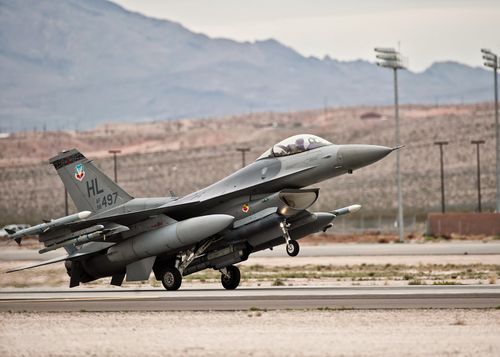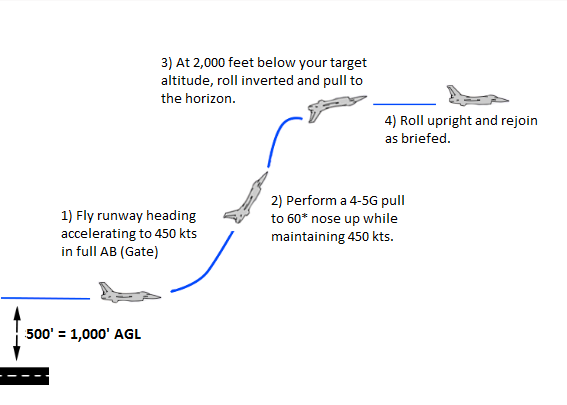Difference between revisions of "Taxi and Takeoff"
| Line 10: | Line 10: | ||
==On The Ramp== | ==On The Ramp== | ||
We do most takeoffs from the Taxiway position. When “takeoff taxi” is called, click the '''Takeoff''' button on the 2D screen and select '''Taxiway'''. | We do most takeoffs from the Taxiway position. When “takeoff taxi” is called, click the '''Takeoff''' button on the 2D screen and select '''Taxiway'''. | ||
| − | |||
| − | |||
| − | |||
| − | |||
| − | |||
| − | |||
==Line Up== | ==Line Up== | ||
| Line 29: | Line 23: | ||
When lined up, turn breaks on, throttle up to 80-ish percent throttle, release the brakes, and then go full afterburner (Gate). The element leader will be calling out and counting down to each action, ensuring a coordinated takeoff. | When lined up, turn breaks on, throttle up to 80-ish percent throttle, release the brakes, and then go full afterburner (Gate). The element leader will be calling out and counting down to each action, ensuring a coordinated takeoff. | ||
| − | Standard Takeoff | + | === Standard Takeoff === |
| + | |||
| + | === Rolling Takeoff === | ||
| + | A rolling takeoff is the most time efficient way to get lots of planes into the air quickly. It's usually performed when the flight is late getting to its TOT and there is no time left for proper line up. Wingmen are cleared to take the active when the aircraft in front of them starts its takeoff roll. | ||
| + | |||
| + | === Formation Takeoff === | ||
| + | In a formation takeoff, flight lead always takes the downwind side of the runway (in case of crosswind). Formation takeoff are performed and follow some flight lead mandatory calls: | ||
| + | |||
| + | * ''"RUN UP"'': pilots apply Vmil (or 90% if the jet is lightly loaded). | ||
| + | * "''BRAKES, BRAKES, NOW"'': pilots release brakes and start rolling. Wingman should keep watching lead to ensure proper deconfliction. | ||
| + | * ''"GATE, GATE, NOW"'' should be called when the afterburner is engaged. Please note, engage full AB with no delay. | ||
| + | * Rotate speed should be known and not called on the radio. | ||
| + | * ''"GEAR, GEAR, NOW"'': pilots retract gear at the same time. During the entire formation takeoff the wingman should maintain a perfect fingertip formation on his lead. | ||
| + | * Flight lead will maintain 350Kts until element has rejoined. | ||
| − | + | === Radar Assisted Trail Departure === | |
| + | RAT is an IFR departure. Single ship takeoff with 20 second spacing. Each flight member will lock the aircraft directly in front of him on FCR, call ''"TIED"'', and fly in trail. The overriding priority must be flying the aircraft, not operating the radar. | ||
| − | + | Radar setting should be RWS 60° scan, Range 10Nm, elevation slightly above horizon (threat volume lowered). No need to call buddy spike/lock when tied calls have been made. | |
| + | |||
| + | RAT departures are performed at full military power and speed is limited to 300kts in IFR. Rejoins in formation happens at the exit point, usually on top of the weather where visual is again possible. | ||
==Climb== | ==Climb== | ||
| − | After taking off initiate a 10 degree climb and check towards steerpoint 2. Turn the afterburner off at 350 knots. | + | After taking off initiate a 10 degree climb and check towards steerpoint 2. Turn the afterburner off at 350 knots. Rejoin should be completed before starting climb to en route altitude. Lead will maintain 5000ft at 350Kts until the flight is formed. |
| − | |||
| − | |||
| − | |||
| − | |||
===Efficient Climb=== | ===Efficient Climb=== | ||
| Line 78: | Line 84: | ||
|0.68 | |0.68 | ||
|} | |} | ||
| + | ===Combat Departure/Climb=== | ||
| + | [[File:Combat Departure-Climb.png|thumb|600px]] | ||
| + | To execute a combat departure, begin the take-off as before (Buster to 100 kts, then Gate) then once airborne fly runway heading while accelerating to 450 KCAS in full afterburner maintaining 1000' AGL (or as briefed), then pitch up 60° using no more than 4-5G. Hold that attitude until within 2,000 feet of your clearance altitude, at which point you roll inverted, pull back down to the horizon before turning back upright at your clearance altitude and setting RPM as needed to maintain airspeed and altitude. | ||
Revision as of 12:36, 19 December 2022
Contents
Learning objectives
- Set up the jet on the ramp
- Taxi to the proper active runway
- Perform rolling, interval and formation takeoffs
- Climb to altitude
On The Ramp
We do most takeoffs from the Taxiway position. When “takeoff taxi” is called, click the Takeoff button on the 2D screen and select Taxiway.
Line Up
Lead always takes downwind side of the runway. The correct visual cue for a wingman to line up on his lead is to align his head with the main gear of the aircraft preceding him.
- 2-ship line up: Echelon. Lead owns the left side of the runway; Wingman has the other side.
- 3-ship line up: Echelon Lead on the far left, #2 on centreline, #3 on far right.
- 4-ship line up: Echelon, #3 in the slot.
Once rolling, aim for the centreline (except for formation takeoffs) Please note, echelon side is left at lead’s discretion but a good lead takes winds into consideration.
Takeoff
When lined up, turn breaks on, throttle up to 80-ish percent throttle, release the brakes, and then go full afterburner (Gate). The element leader will be calling out and counting down to each action, ensuring a coordinated takeoff.
Standard Takeoff
Rolling Takeoff
A rolling takeoff is the most time efficient way to get lots of planes into the air quickly. It's usually performed when the flight is late getting to its TOT and there is no time left for proper line up. Wingmen are cleared to take the active when the aircraft in front of them starts its takeoff roll.
Formation Takeoff
In a formation takeoff, flight lead always takes the downwind side of the runway (in case of crosswind). Formation takeoff are performed and follow some flight lead mandatory calls:
- "RUN UP": pilots apply Vmil (or 90% if the jet is lightly loaded).
- "BRAKES, BRAKES, NOW": pilots release brakes and start rolling. Wingman should keep watching lead to ensure proper deconfliction.
- "GATE, GATE, NOW" should be called when the afterburner is engaged. Please note, engage full AB with no delay.
- Rotate speed should be known and not called on the radio.
- "GEAR, GEAR, NOW": pilots retract gear at the same time. During the entire formation takeoff the wingman should maintain a perfect fingertip formation on his lead.
- Flight lead will maintain 350Kts until element has rejoined.
Radar Assisted Trail Departure
RAT is an IFR departure. Single ship takeoff with 20 second spacing. Each flight member will lock the aircraft directly in front of him on FCR, call "TIED", and fly in trail. The overriding priority must be flying the aircraft, not operating the radar.
Radar setting should be RWS 60° scan, Range 10Nm, elevation slightly above horizon (threat volume lowered). No need to call buddy spike/lock when tied calls have been made.
RAT departures are performed at full military power and speed is limited to 300kts in IFR. Rejoins in formation happens at the exit point, usually on top of the weather where visual is again possible.
Climb
After taking off initiate a 10 degree climb and check towards steerpoint 2. Turn the afterburner off at 350 knots. Rejoin should be completed before starting climb to en route altitude. Lead will maintain 5000ft at 350Kts until the flight is formed.
Efficient Climb
For efficient climbs in the F-16: set mil power, reference the entry for your drag index. Pitch to hold the indicated airspeed for in the climb until reaching that mach number, and then pitch to hold the mach throughout the climb.
| DRAG INDEX | KIAS | MACH |
|---|---|---|
| 0 | 445 | 0.84 |
| 50 | 425 | 0.84 |
| 100 | 400 | 0.84 |
| 150 | 385 | 0.82 |
| 200 | 365 | 0.80 |
| 300 | 340 | 0.75 |
| 400 | 320 | 0.68 |
Combat Departure/Climb
To execute a combat departure, begin the take-off as before (Buster to 100 kts, then Gate) then once airborne fly runway heading while accelerating to 450 KCAS in full afterburner maintaining 1000' AGL (or as briefed), then pitch up 60° using no more than 4-5G. Hold that attitude until within 2,000 feet of your clearance altitude, at which point you roll inverted, pull back down to the horizon before turning back upright at your clearance altitude and setting RPM as needed to maintain airspeed and altitude.
Fence check
The fence check is the final preparation for taking your aircraft into combat.
The flight leader will call “Flight fence in”, at which point you should turn Master Arm switch to ARM, turn your exterior lights off (at night you should leave the anti collision light on), and ensure any weapons that require it are powered on (Mavericks and HARMs, for example).
Confirm the Fence in call by reading off the first three numbers on your fuel gauge.
Comms example:
- Lead: "Flight, fence in. Lead's fenced 091"
- 2: "Two fenced 090"
- 3: "Three fenced 091"
- 4: "Four fenced 089"
{{#invoke:Navbox|navbox}}


